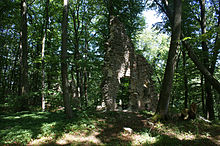Helfenberg castle ruins (Upper Palatinate)
| Helfenberg castle ruins | ||
|---|---|---|
|
Helfenberg Castle |
||
| Alternative name (s): | Helfenburg, Helfenberg Castle | |
| Creation time : | First mentioned in 1230 | |
| Castle type : | Hilltop castle | |
| Conservation status: | ruin | |
| Standing position : | Ministeriale | |
| Place: | Velburg | |
| Geographical location | 49 ° 14 '22.6 " N , 11 ° 38' 29" E | |
| Height: | 612.8 m above sea level NN | |
|
|
||
The castle ruin Helfenberg (also known as Helfenburg ) is located near Velburg in the Upper Palatinate .
Geographical location
The ruins of the Höhenburg are on the Helfenberg, a 613 meter high mountain in the Upper Palatinate Jura , east of the Lengenfeld district of Velburg, directly on the federal motorway 3 . There is a parking lot with a map on the connecting road between Lengenfeld and Velburg. From there, the publicly accessible ruin can be reached in around 15 to 20 minutes.
history
Bronze Age tombs around the mountain give rise to the assumption that a fortified ring wall was already on the mountain in prehistoric times . Due to the rampart on the plateau 25 m below the castle ruins, H. Rädle suspects an older ring rampart from the 10th or 11th century.
It was first mentioned in writing in an undated document from the years 1198–1217, in which Count Ulrich von Velburg assigned the castle to the Regensburg monastery . The first administrator of the castle was the Episcopal Regensburg servant Wirnt von Plankenstein, who can be proven from around 1196 to 1224. From there it went in 1232 as a fiefdom to the Hohenfelser, a ministerial family of the Regensburg bishops, which changed its name after a failed assassination attempt by Konrad von Hohenfels on the Roman-German King Konrad IV and named itself Ehrenfelser after one of their castles. After 1370, Count Palatine Ruprecht I of the Palatinate acquired the castle. In Landshut War of Succession it was burned down. During the Thirty Years War , the castle, like the entire Palatinate property in the Upper Palatinate, fell to the Bavarian Duke Maximilian in 1628 , who gave the castle and rule to his general Johann t'Serclaes Graf von Tilly in 1632 . 1699–1707, Count Ferdinand Lorenz Xaver Tilly converted the castle into a baroque palace. The Munich painter Hans Georg Asam , father of the Asam brothers, was involved in the interior decoration .
The representative palace building only stood for around a hundred years. After the Tilly family died out, the castle fell to the Bavarian elector , who appointed a nurse. In 1796 French revolutionary troops looted the castle, which has been abandoned since then. In 1807 it was sold for demolition for 200 guilders; Step by step, parts were broken off. The stones served as material for buildings in the area.
description
Only the foundations and remains of the outer walls of the former castle have survived. The ruin is overgrown by the forest. No measures have been taken to secure the building remains. A few parts of the furniture have been preserved and can be viewed at Gasthof Winkler in Lengenfeld. The altarpiece of the former castle church, by Georg Asam , is in the Lengenfeld church.
literature
- Günter Moser, Bernhard Setzwein, Mathias Conrad: Upper Palatinate Castles - A journey to the witnesses of the past . Book and Kustverlag Oberpfalz, Amberg 2004, ISBN 3-935719-25-6 , pp. 104-105.
- Herbert Rädle: Castles and fortress stables in the Neumarkt district - A guide to historical sites . Published by the district of Neumarkt in der Oberpfalz, Neumarkt o. J., ISBN 3-920142-14-4 , pp. 45–47.
Web links
Individual evidence
- ↑ Rädle, Burgen und Burgställe, p. 45 f.
- ^ B. Schneider, The Counts of Velburg and their relatives, Neumarkter historical contributions 16, Neumarkt / Opf. 2019, p. 76 f.
- ↑ M. Jehle, Historical Atlas of Bavaria: Parsberg, Munich 1981, p. 45 f.
- ↑ W. Steiner described the decline of the castle in detail in WR Steiner, Walks in Landscape and History, Neumarkter Historical Contributions 15, Neumarkt 2016, pp. 110–118.





